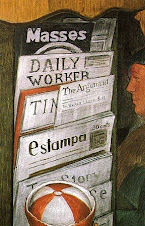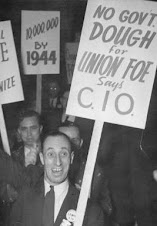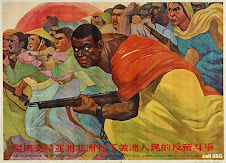Sunday, December 25, 2011
Half of U.S. Poor - Karl Marx Was Right
By Fred Goldstein
Published Dec 21, 2011 10:59 PM
The number of people in the U.S. who are officially poor or “near poor” has become a matter of controversy.
The Census Bureau has changed the method by which it measures official poverty. Now, regional differences are taken into account when calculating the costs of maintaining a family, as well as adding any government assistance — like food stamps — to a family’s income while subtracting medical, transportation, childcare and other expenses.
The New York Times requested figures from the Census Bureau based upon these new methods of calculating official poverty. The new percentage was shocking. The Times published its findings in November. It declared the number living in poverty to be 100 million, or one in every three people in the U.S.
But a month later, in December, the Associated Press published its findings based on the new calculations. It found that 150 million — meaning nearly one out of every two people — were either poor or “near poor.” Near poor means struggling to pay bills.
This was even more shocking.
Both numbers were based on the same Census Bureau findings. The difference is that the first study counted all people living at 150 percent of the poverty level or below. The official poverty level for a family of four with two children, under the new measures adopted by the Bureau, was set at an annual income of $24,343.
The second study, using the same data base, included people living at 200 percent of the poverty level or below. It found that a family of four, including two children, with a yearly income of $48,686 was still struggling to survive and lived precariously close to going under. Anyone trying to hold together a family of four on this income will certainly agree with the broader definition.
The Census Bureau rushed to “clarify” the situation, declaring that finding half the people in the U.S. were poor or “near poor” was erroneous. Anyway, they said, the government has no definition of “low income” or “near poor,” so the whole discussion is wrong. This discussion then quickly disappeared from the big business media.
‘You don’t need a weatherman’
No matter which number is taken, the fact is that real wages have been falling for 30 years as capitalists put in new technology, speed up workers and force millions of workers into part-time hours. Since the economic crisis began in August 2007, wages have fallen even more sharply. At least 30 million are unemployed or underemployed. Millions have been foreclosed out of their homes. And government assistance is being cut to the bone at the federal, state and local levels.
In other words, the debate over how much poverty exists according to government statistics is just a debate over government definitions and Census Bureau categories. The poverty and suffering are real and going up, regardless. And even by official statistics, poverty in the U.S. rose by 2.6 million from 2009 to 2010.
As the saying goes, ‘you don’t need a weatherman’ to know which way the wind is blowing. Poverty is built into capitalism. During an economic crisis of this duration and severity, poverty grows deeper and wider.
Karl Marx on the 1% and the 99%
It is worth reiterating that the growth of poverty is built into capitalism. In fact, Karl Marx, writing in the “Communist Manifesto” in 1848, foreshadowed the description of the 1% versus the 99%.
Arguing against the capitalists, who were complaining about the communist program of abolishing private property in the means of production, Marx wrote:
“You are horrified at our intending to do away with private property. But in your existing society, private property is already done away with for nine-tenths of the population; its existence for the few is solely due to its non-existence in the hands of those nine-tenths. You reproach us, therefore, with intending to do away with a form of property, the necessary condition for whose existence is the non-existence of any property for the immense majority of society.
“In one word, you reproach us with intending to do away with your property. Precisely so; that is just what we intend.”
Marx wrote about the one-tenth of the population versus the nine-tenths during the very early stages of capitalism, before the vast concentration of wealth, which he foresaw, had reached 21st century proportions. In fact, today just a tiny fraction of the 1%, the billionaires, actually control the wealth.
Marx wrote 160 years ago, before the era of finance capital with its hedge funds and undreamed of wealth. But although he wrote of the 10 percent and the 90 percent, he noted and analyzed how the tendency of capitalism is to concentrate wealth in fewer and fewer hands, leaving the masses with no property and living in poverty.
After 20 more years of further studies of capitalism, Marx in 1867 wrote in “Capital,” Volume 1, Chapter 25, on the “General Law of Capitalist Accumulation.” He described the role of technology in creating poverty and an ever-increasing number of unemployed workers, which he called “the reserve army of the unemployed”:
“The law, finally, that always equilibrates the relative surplus population, or industrial reserve army, to the extent and energy of accumulation, this law rivets the laborer to capital more firmly than the wedges of Vulcan did Prometheus to the rock. It establishes an accumulation of misery, corresponding with accumulation of capital. Accumulation of wealth at one pole is, therefore, at the same time accumulation of misery, agony of toil, slavery, ignorance, brutality, mental degradation, at the opposite pole, i.e., on the side of the class that produces its own product in the form of capital.” [Both the “Communist Manifesto” and “Capital” can be read online at marxists.org/archive.]
But Marx did not just describe poverty and inequality of wealth. He analyzed its origins in the relationship of labor to capital. He showed that the profit system, the private property system, is built upon workers selling their labor power to employers, who use it to increase their capital, their profits and their personal wealth
This is as true today as it was in 1848 and 1867. The same laws described by Marx have brought about the world economic crisis that we are living through. The laws of capitalism, especially the permanent, built-in competitive drive for profits, also drive technology, speedups, low wages, overproduction and ultimately the destruction of jobs and income for the masses of people.
The polarization of society into the 1% and the 99% is systemic. And it is the system which in the long run must be destroyed.
In the meantime, the Occupy Wall Street movement has pushed society a large step forward by exposing the rich and taking action against them. In so doing it has awakened large sections of society to realize that their poverty, their dead-end jobs, their struggles to survive, are not their fault but the fault of the system.
Thus, OWS has legitimized and widely disseminated opposition to the system, moving us all a step closer to being able to get rid of the 1% altogether and establish the rule of the 99% — that is, get rid of the autocratic capitalist ruling class and establish the democratic rule of the workers and the oppressed.
Subscribe to:
Post Comments (Atom)










































No comments:
Post a Comment